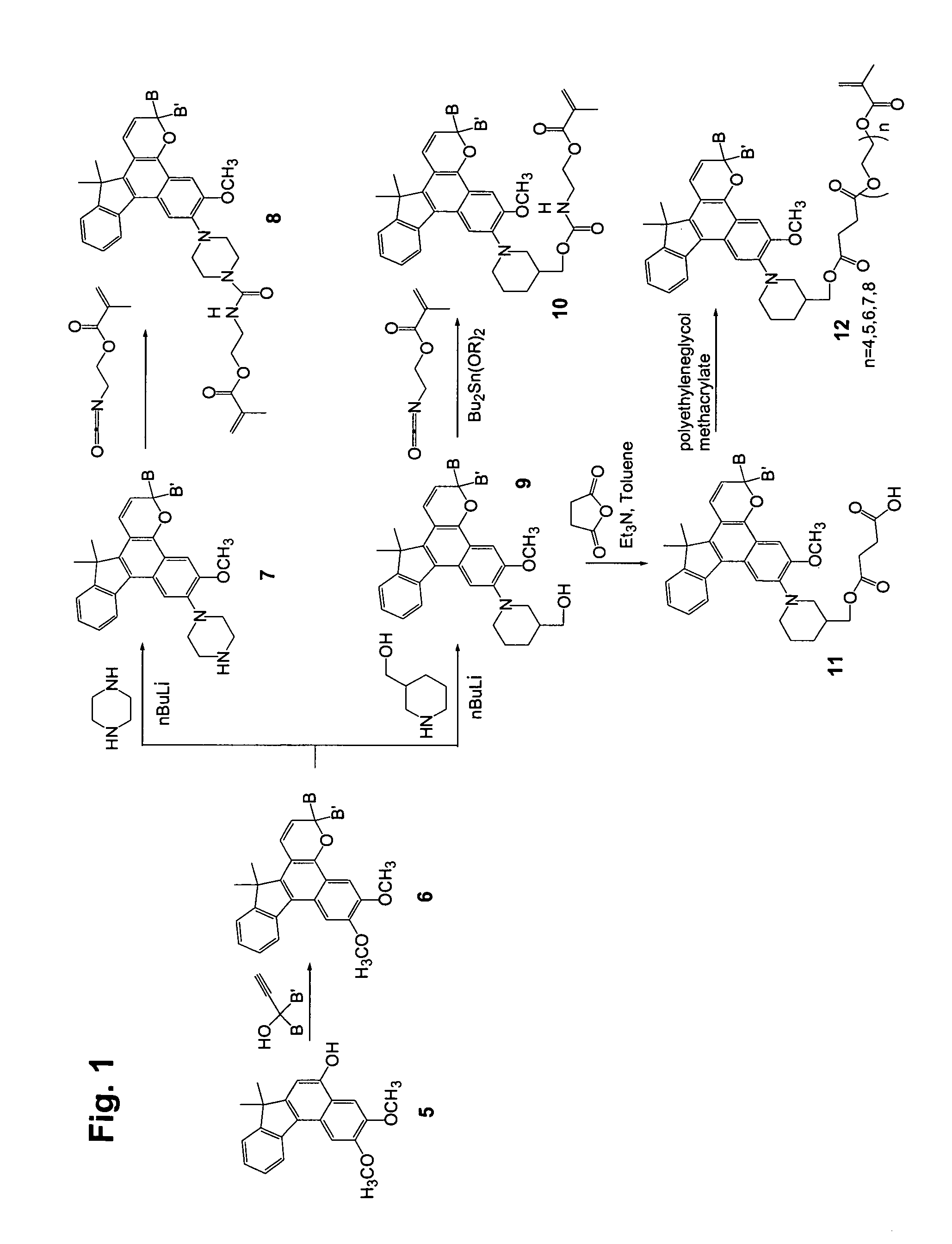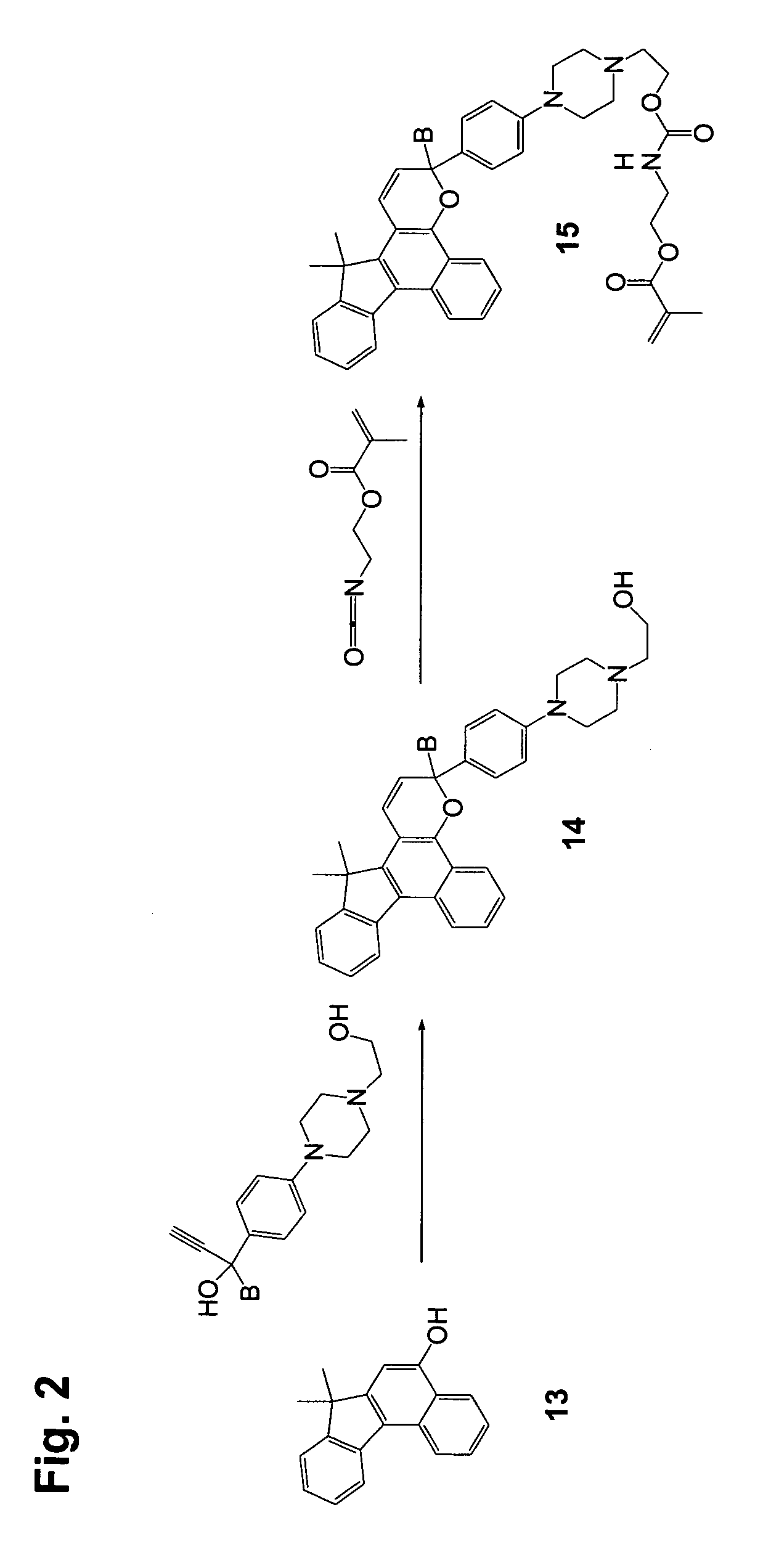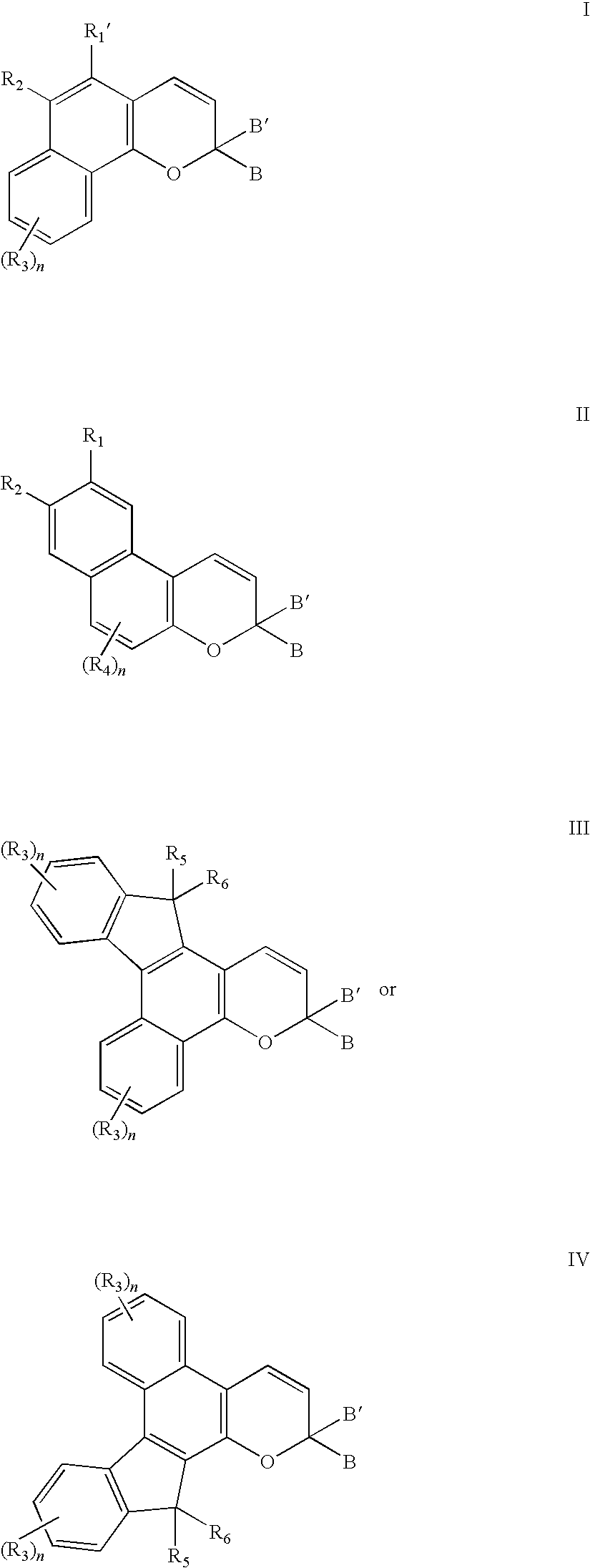Photochromic materials with reactive substituents
a technology of photochromic materials and reactive substituents, applied in the field of photochromic materials, can solve the problems of difficulty in purification, the purity of the resultant photochromic materials that is readily available,
- Summary
- Abstract
- Description
- Claims
- Application Information
AI Technical Summary
Problems solved by technology
Method used
Image
Examples
example 1
[0155]Step 1
[0156]2,3-Dimethoxy-7,7-dimethyl-7H-benzo[C]fluoren-5-ol (10 g), 1-phenyl-1-(4-morpholinophenyl)-2-propyn-1-ol (13 g), dodecyl benzenesulfonic acid (10 drops), and chloroform (400 mL) were combined in a reaction flask. The reaction mixture was heated at reflux for 3 hours and concentrated. Acetone was added to the residue, and the slurry was filtered, yielding 18 g of off-white solid.
[0157]Step 2
[0158]3-Phenyl-3-(4-morpholinophenyl)-6,7-dimethoxy-13,13-dimethyl-3H,13H-indeno[2′,3′:3,4]naphtho[1,2-b]pyran from Step 1 (20 g), 3-piperidinomethanol (7.6 g), and tetrahydrofuran (250 mL) were combined in a dry reaction flask cooled with ice bath under nitrogen atmosphere. Butyl lithium in hexane (2.5 M, 50 mL) was added to the reaction mixture dropwise under stirring. The cooling bath was removed after the addition and the flask was warmed to room temperature. The dark solution was poured into ice water (400 mL) and the mixture was extracted with ethyl acetate (twice with 400 ...
example 2
[0161]Step 1
[0162]The procedure of Step 2 of Example 1 was followed except that 4-hydroxypiperidine was used in place of 3-piperidinomethanol. The product was obtained as off-white crystals.
[0163]Step 2
[0164]The procedure of Step 3 of Example 1 was followed except that 3-phenyl-3-(4-morphlinophenyl)-6-methoxy-7-(4-hydroxypiperidin-1-yl)-13,13-dimethyl-3H,13H-indeno[2′,3′:3,4]naphtho[1,2-b]pyran (from Step 1) was used in place of 3-phenyl-3-(4-morpholinophenyl)-6-methoxy-7-(3-hydroxymethylenepiperidin-1-yl)-13,13-dimethyl-3H,13H-indeno[2′,3′:3,4]naphtho[1,2-b]pyran. The product was obtained as purple-tinted crystals. Mass spectrometry supports the molecular weight of 3-phenyl-3-(4-morphlinophenyl)-6-methoxy-7-(4-(2-methacryloxyethyl)carbamyloxypiperidin-1-yl)-13,13-dimethyl-3H,13H-indeno[2′,3′:3,4]naphtho[1,2-b]pyran.
example 3
[0165]Step 1
[0166]The procedure of Step 2 of Example 1 was followed except that piperazine was used in place of 3-piperidinomethanol. The product was obtained as purple-tinted crystals.
[0167]Step 2
[0168]3-Phenyl-3-(4-morpholinophenyl)-6-methoxy-7-(4-piperazin-1-yl)-13,13-dimethyl-3H,13H-indeno[2′,3′:3,4]naphtho[1,2-b]pyran from Step 1 (10 g), 2-isocyanatoethyl methacrylate (3 mL) and ethyl acetate (150 mL) were combined in a dry reaction flask open to air. The mixture was stirred at room temperature for 20 minutes. Methanol (5 mL) was added to the mixture to quench excess 2-isocyanatoethyl methacrylate. The mixture was concentrated and the residue was purified by silica gel chromatography (ethyl acetate / hexanes (v / v): 1 / 1). After the chromatography, the product was crystallized from ethyl acetate / hexanes (v / v: 1 / 1) and filtered off as purple-tinted crystals (10 g). Mass spectrometry supports the molecular weight of 3-phenyl-3-(4-morpholinophenyl)-6-methoxy-7-(4-(2-methacryloxyethyl)...
PUM
| Property | Measurement | Unit |
|---|---|---|
| temperature | aaaaa | aaaaa |
| temperature | aaaaa | aaaaa |
| temperature | aaaaa | aaaaa |
Abstract
Description
Claims
Application Information
 Login to View More
Login to View More - R&D
- Intellectual Property
- Life Sciences
- Materials
- Tech Scout
- Unparalleled Data Quality
- Higher Quality Content
- 60% Fewer Hallucinations
Browse by: Latest US Patents, China's latest patents, Technical Efficacy Thesaurus, Application Domain, Technology Topic, Popular Technical Reports.
© 2025 PatSnap. All rights reserved.Legal|Privacy policy|Modern Slavery Act Transparency Statement|Sitemap|About US| Contact US: help@patsnap.com



